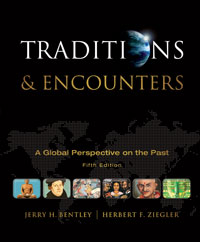
Traditions and Encounters, AP Edition (Bentley), 5th EditionChapter 7: The Empires of PersiaOverviewThis chapter describes the series of empires that arose in Persia (modern-day Iran) and controlled much of the territory between the Mediterranean Sea and India for over one thousand years, from about 550 B.C.E. through 650 C.E. The first empire, founded by Cyrus the Achaemenid, expanded under him and his successors until it became the largest empire the world had ever seen. The four Persian dynasties of this era (Achaemenid, Seleucid, Parthian, and Sassanid) were noted for several important developments:
|  |















